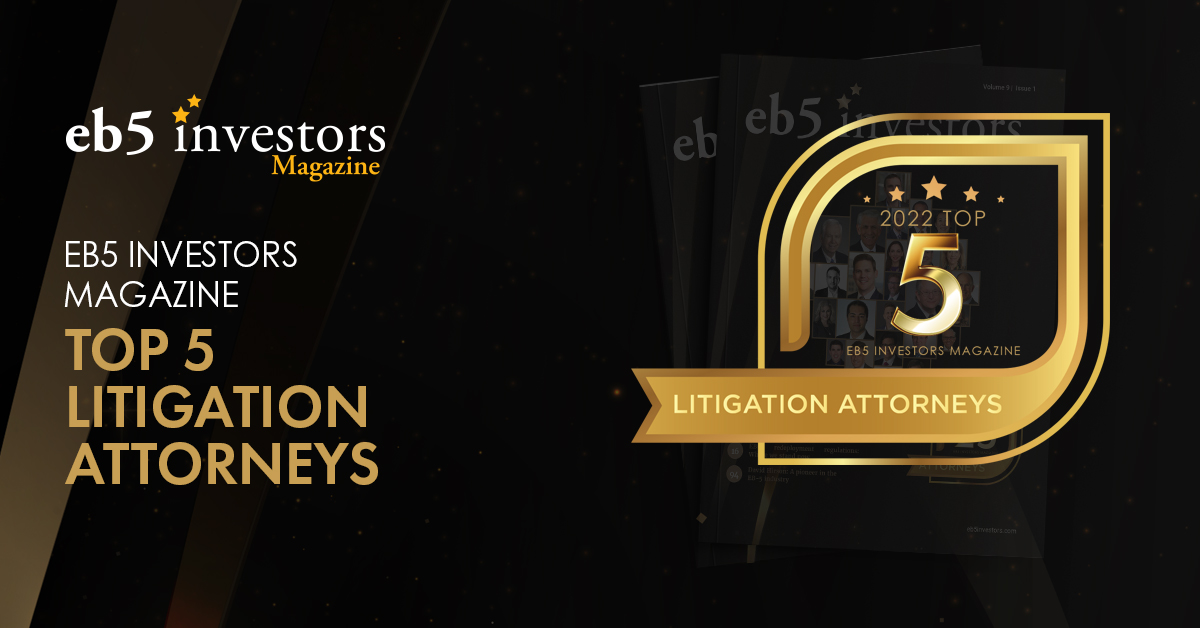
EB5 Investors Magazine is pleased to announce the Top Litigation Attorneys. To be eligible, distinguished attorneys needed to perform litigation and related legal services for the EB-5 program.
For more information or to contact any of these professionals, we invite you to view their listings at www.EB5Investors.com/directories.
ROBERT V. CORNISH, JR.
Law Offices of Robert V. Cornish, Jr.
 Bob Cornish is a securities and litigation attorney with over 25 years of experience in handling matters for investors and others in the global financial markets. Prior to forming his own firm last year, he was a partner at respected U.S. law firms. Cornish has held the FINRA Series 24 General Securities Principal license. His current litigation practice concentrates on serving both EB-5 investors and regional centers in a variety of securities and commercial matters, including those in U.S. courts and in arbitration. Cornish maintains law licenses in New York, Tennessee, Arkansas, Wyoming and DC, and has litigated in courts in Florida, California and elsewhere. He also serves as an expert witness in EB-5 matters, has been ranked a Top 5 Litigation Attorney by EB5 Investors Magazine for several years, and designated a “Super Lawyer” in securities litigation matters.
Bob Cornish is a securities and litigation attorney with over 25 years of experience in handling matters for investors and others in the global financial markets. Prior to forming his own firm last year, he was a partner at respected U.S. law firms. Cornish has held the FINRA Series 24 General Securities Principal license. His current litigation practice concentrates on serving both EB-5 investors and regional centers in a variety of securities and commercial matters, including those in U.S. courts and in arbitration. Cornish maintains law licenses in New York, Tennessee, Arkansas, Wyoming and DC, and has litigated in courts in Florida, California and elsewhere. He also serves as an expert witness in EB-5 matters, has been ranked a Top 5 Litigation Attorney by EB5 Investors Magazine for several years, and designated a “Super Lawyer” in securities litigation matters.
What new trends are you seeing when it comes to EB-5 litigation?
The less viable projects that made their way to market in the rush to meet demand years ago have met their days of reckoning. Those who made efforts to conduct business in a commercially reasonable and fair manner have weathered the storm, while those who have not now face the wrath of angry investors. This is to be expected, and the industry must realize that holding bad actors accountable for their actions enhances the integrity of our industry both domestically and abroad. People come to the United States expecting the rule of law to help them, and that perception must be as close to reality as possible. I’m hopeful that the recent EB-5 reforms will prevent many bad things from the past.
What has been your most impactful EB-5 litigation case, and why?
My most impactful case was one I recently handled for a group of investors who placed their trust in a regional center whose principal used their property for collateral on a mortgage and thereafter fled the United States to parts unknown. We have been successful in getting these people to a reasonable point of recovery and educating them about the legal process in the United States at the same time. Ironically, we are now educating them about legal processes in places they never dreamed of before while we chase the fraudsters down. While our process of justice sometimes seems slow to those not familiar with it, people have come to learn that more often than not, their case will be heard.
MATTHEW GALATI
The Galati Law Firm
 Matthew Galati has represented hundreds of EB-5 stakeholders, including investors, developers, regional centers and others since 2011. Following unprecedented USCIS delays and decision making, Galati has pivoted much of his practice to be more litigation-focused. He has represented hundreds of investors facing delays and denials, as well as regional centers seeking project approvals. This is his second consecutive time being named a Top 5 EB-5 Litigation Attorney. Galati was recently given the American Immigration Lawyers Association’s 2022 Joseph Minsky Young Lawyer Award for his outstanding contributions made as a young lawyer in the field of immigration and nationality law.
Matthew Galati has represented hundreds of EB-5 stakeholders, including investors, developers, regional centers and others since 2011. Following unprecedented USCIS delays and decision making, Galati has pivoted much of his practice to be more litigation-focused. He has represented hundreds of investors facing delays and denials, as well as regional centers seeking project approvals. This is his second consecutive time being named a Top 5 EB-5 Litigation Attorney. Galati was recently given the American Immigration Lawyers Association’s 2022 Joseph Minsky Young Lawyer Award for his outstanding contributions made as a young lawyer in the field of immigration and nationality law.
What new trends are you seeing when it comes to EB-5 litigation?
It’s become frustrating to see some attorneys think (and advertise) that cases can be sped up or denials reversed by merely filing a Complaint. Litigation is, by definition, adversarial. We go into the process expecting that we have to fight the fight to the bitter end. Given the flood of litigation hitting the courts, the Government is not just going to surrender every time. Litigation requires a mindset to fight for the clients and not back away from pushback or initial adversity. Our clients have respected the approach we take and our willingness to move the law forward, as opposed to only taking the “easy” cases. How else are we to save future EB-5 stakeholders from needing more litigation?
What has been your most impactful EB-5 litigation case, and why?
Nandu v. Jaddou, 21-cv-00643 (C.D. Cal. Sep. 24, 2021) was a personal triumph. This was an I-485 mandamus case and the case law was definitely not in our favor. We pushed against the Government’s motion to dismiss even though the regional center program had lapsed. I was far from certain this strategy would work, but very few things in litigation are certain. We were ecstatic to survive the motion to dismiss and now establish a precedent that is incredibly important for green card delays in the EB-5 realm and beyond. Hopefully USCIS now recognizes that they cannot ignore EB-5 stakeholders and assume courts will rubberstamp their lack of action.
MEGAN GUZMAN
David Hirson & Partners
 Megan Guzman is of counsel at David Hirson & Partners, LLP for litigation matters. Her passion is finding solutions to cases with complex problems – whether that be through I-290B Appeals or Motions, waivers, or federal litigation – for EB-5 and non-EB-5 cases. Guzman has significant federal litigation experience filing mandamus actions for declaratory relief, and challenging wrongful denials under the Administrative Procedure Act (APA). Her successes include securing temporary restraining orders and preliminary injunctions. Prior to joining DHP, Guzman represented individuals in immigration court, including appellate representation before the Board of Immigration Appeals and the Ninth Circuit.
Megan Guzman is of counsel at David Hirson & Partners, LLP for litigation matters. Her passion is finding solutions to cases with complex problems – whether that be through I-290B Appeals or Motions, waivers, or federal litigation – for EB-5 and non-EB-5 cases. Guzman has significant federal litigation experience filing mandamus actions for declaratory relief, and challenging wrongful denials under the Administrative Procedure Act (APA). Her successes include securing temporary restraining orders and preliminary injunctions. Prior to joining DHP, Guzman represented individuals in immigration court, including appellate representation before the Board of Immigration Appeals and the Ninth Circuit.
What new trends are you seeing when it comes to EB-5 litigation?
Right now, we are seeing more and more investors wanting to file writ of mandamus cases for pending I-829 petitions. It is inexcusable that USCIS did not use the lapse in the regional center program to make significant progress on the backlog of these petitions, and they should be held accountable for this inaction. The I-829 is one of the few immigration case types that has a statutory deadline for adjudication (90 days), yet we see estimated processing times of 57 months. The chasm between these two timelines is unacceptable.
What has been your most impactful EB-5 litigation case, and why?
Last year I filed a writ of mandamus for an I-829 petition that had been pending since August 1999 as a result of USCIS’s failure to promulgate regulations related to Public Law 107-273. In 2007, two of the family members filed for naturalization since they had been conditional permanent residents for over five years. USCIS held the applications in abeyance since the I-829 hadn’t been approved at that time. Not only were we able to get the I-829 petition approved, but also those 15-year-old N-400s. The two sisters became citizens last month!
IRA KURZBAN
Kurzban Kurzban Tetzeli & Pratt
 Ira Kurzban is a founder of the law firm of Kurzban, Kurzban, Tetzeli & Pratt, P.A., of Miami, Florida. He is a past-national president and former General Counsel of the American Immigration Lawyers Association and is a Fellow of the American Bar Association. He has litigated over 50 federal cases concerning the rights of aliens, including Jean v. Nelson, Commissioner v. Jean, and McNary v. Haitian Refugee Center, Inc., which he argued before the United States Supreme Court. For over 30 years, he has also litigated the most prominent EB-5 cases in the field of immigration law. Kurzban is an adjunct faculty member in immigration and nationality law at the University of Miami School of Law. He is the author of Kurzban’s Immigration Law Sourcebook. He has lectured and otherwise published extensively in the field of immigration law, including articles in the Harvard Law Review and Columbia University Press.
Ira Kurzban is a founder of the law firm of Kurzban, Kurzban, Tetzeli & Pratt, P.A., of Miami, Florida. He is a past-national president and former General Counsel of the American Immigration Lawyers Association and is a Fellow of the American Bar Association. He has litigated over 50 federal cases concerning the rights of aliens, including Jean v. Nelson, Commissioner v. Jean, and McNary v. Haitian Refugee Center, Inc., which he argued before the United States Supreme Court. For over 30 years, he has also litigated the most prominent EB-5 cases in the field of immigration law. Kurzban is an adjunct faculty member in immigration and nationality law at the University of Miami School of Law. He is the author of Kurzban’s Immigration Law Sourcebook. He has lectured and otherwise published extensively in the field of immigration law, including articles in the Harvard Law Review and Columbia University Press.
What new trends are you seeing when it comes to EB-5 litigation?
There is little doubt that litigation in EB-5 and elsewhere under the INA has skyrocketed over the past year. There is more litigation over immigration issues and particularly business issues than I have seen in the past four decades. In the EB-5 area there have been scores of mandamus cases filed and substantive and procedural challenges to EB-5 policies and interpretations. The most prominent cases have been challenges first to EB-5 regulations prior to the EB-5 Reform and Integrity Act and later, post-Reform and Integrity provision challenges.
What has been your most impactful EB-5 litigation case, and why?
Many years ago, my firm was perhaps the first immigration law firm in the United States to apply the Administrative Procedure Act and particularly the notice and comment requirements of the APA to agency action under the INA. It is gratifying to see that after all these years APA and notice and comment challenges are common in litigation against USCIS. Most recently, our case this term in the U.S. Supreme Court in Patel v. Garland will likely impact EB-5 clients, particularly those investors placed in removal proceedings.
DANIEL LUNDY
Klasko Immigration Law Partners
 Daniel B. Lundy is a partner at Klasko Immigration Law Partners and leads the firm’s EB-5 regional center and developer practice and the litigation team. He has been deeply involved in EB-5 litigation against USCIS denials and delays. He also advises clients on EB-5 projects involved in civil litigation. Lundy has litigated hundreds of immigration cases, including adjustment of status and waiver denials; I-526 and I-829 denials; H-1B, L-1, EB-1 and other immigration denials before the U.S. District Courts, U.S. Courts of Appeals, and the U.S. Supreme Court. He regularly advises clients in all aspects of EB-5 and immigration.
Daniel B. Lundy is a partner at Klasko Immigration Law Partners and leads the firm’s EB-5 regional center and developer practice and the litigation team. He has been deeply involved in EB-5 litigation against USCIS denials and delays. He also advises clients on EB-5 projects involved in civil litigation. Lundy has litigated hundreds of immigration cases, including adjustment of status and waiver denials; I-526 and I-829 denials; H-1B, L-1, EB-1 and other immigration denials before the U.S. District Courts, U.S. Courts of Appeals, and the U.S. Supreme Court. He regularly advises clients in all aspects of EB-5 and immigration.
What new trends are you seeing when it comes to EB-5 litigation?
Delays in EB-5 adjudications have not improved. Mandamus actions for I-829 delays continue to be extremely effective, while I-526 or I-485 cases are more likely to be defended by the government. We see a decline in the quality of the few USCIS decisions that are being issued and expect an uptick in litigation as a result. Notably, we are hearing reports of I-829 denials based on sources of funds that were approved by USCIS at the I-526 stage.
What has been your most impactful EB-5 litigation case, and why?
Liu v. Mayorkas, 20-cv-654 (District of D.C.) is a recent impactful decision. This case stemmed from I-526 adjudication delays. The Court denied the government’s motion to dismiss, finding that our arguments that USCIS had intentionally slowed down the processing of EB-5 cases, supported by a substantial decrease in the number of I-526s processed each year, was sufficient to raise a plausible claim of unreasonable delay. The court refused to take a USCIS website posting as evidence of actual practices at USCIS, and found that the 6-month adjudication time frame suggested by Congress, while not binding, was important.
DISCLAIMER: The views expressed in this article are solely the views of the author and do not necessarily represent the views of the publisher, its employees. or its affiliates. The information found on this website is intended to be general information; it is not legal or financial advice. Specific legal or financial advice can only be given by a licensed professional with full knowledge of all the facts and circumstances of your particular situation. You should seek consultation with legal, immigration, and financial experts prior to participating in the EB-5 program Posting a question on this website does not create an attorney-client relationship. All questions you post will be available to the public; do not include confidential information in your question.







